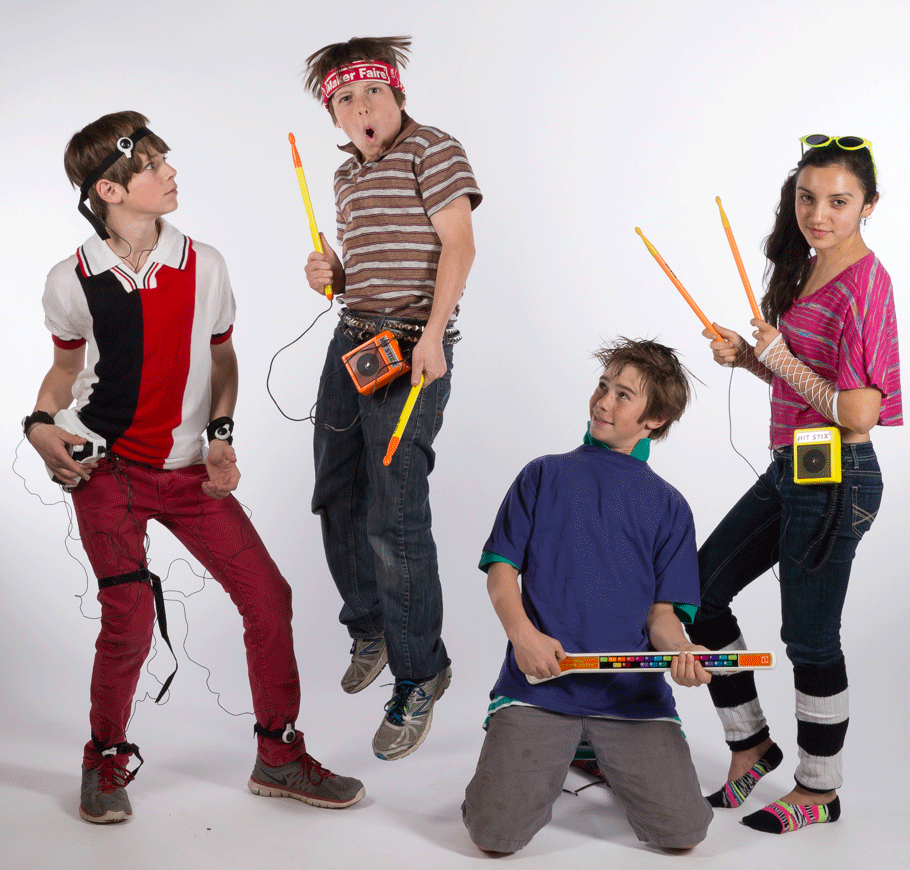
This article first appeared in MAKE Volume 38, on pages 20–21.
The 1980s brought big changes for electronic toys. Advances in integrated circuits meant electronics became inexpensive enough to be used in toys of all kinds, especially in musical toys. Instead of plastic ukuleles or plinky pianos, these musical toys were something new, with new sounds, new methods of playing, and new toyetic forms.
Playskool’s cheap and cheerful entry into musical preschool toys was Major Morgan. He had a keypad with overlays that showed how to play a tune using color-coded grids. Just swap out his overlay for a new song. The hard keypad offered no tactile feedback (oww!) and the sound circuit produced just a single note at a time, but no matter: kids had fun with this musical soldier.
Mattel was aiming for an older crowd with their Rhythm Machine. This cute keyboard featured two disco-licious features: a pitch-bending wheel (wow-weEEEee…!) and a toy version of a beat box with three different drum-and-bass loops. Choose disco, Latin, or pop beats and adjust the tempo. The synthesized rhythms featured a busy bass line with a synth drum. Play along on the mini piano keys. This instantly kitschy music toy was used by the group Kraftwerk on their hit song “Pocket Calculator” in 1981.
Mattel’s Star Maker Guitar promised “hot” sounds, but with only one string, musical choices were limited. Pluck the thick string and press it against the molded plastic frets to change pitch. The best part was a built-in “fuzz tone” effect for a fat, distortion-soaked sound. Unlike its real-world counterpart with magnetic pickups, this toy guitar had an optical pick up that “saw” the motion of the vibrating string. The speaker was mounted directly underneath the string, producing endless feedback and long sustain. Young would-be Eddie Van Halens, shred on!
How about a drum set— without any drums? Nasta’s Hit Stix were a big hit that didn’t actually hit anything. Kids could play “air drums” with a big sound.Inside the tip of each drumstick was an inertial switch that triggered the snare drum sound circuit when the stick was hit or shaken. It also triggered a trend in other “air” instruments.
One of the weirder toys was Hasbro’s Body Rap. Strap on an array of little switches and then slap your own thighs, ankles, wrists, and head to beat out a rhythm of sampled drums, cymbals, and even the spoken words “body” and “rap” — 80s hairdo not included.
Perhaps the most iconic 80s music toy was the Magical Musical Thing from Mattel. The TV commercial featured a kid playing melodies with one finger on the toy’s keypad strip—and finishing by playing it with his head! It featured a sound circuit that was designed around the cheapest and most basic building block of digital electronics: the 4049 CMOS hex inverter chip.
Usually used for decoders and multiplexers, the lowly 4049 was re-imagined by Mattel’s thrifty engineers to create musical tones. Three of the IC’s six logic gates were linked head-to-tail with a resistor and capacitor to create a simple, self-oscillating on-off/on-off square wave generator. The output of this oscillator was hooked up to the remaining three inverters in parallel. Their combined outputs were just enough to directly drive a speaker, with no audio amplifier needed!
A network of resistors created the various musical tones. This was done using a cleverly designed membrane switch pad. The top and bottom layers were made from a single, folded piece of Mylar, printed with conductive silver traces connecting strips of resistive paint. The middle layer was a die-cut insulated spacer with holes positioned to make touch points, each labeled for a different color-coded musical note.Touching the membrane pressed together two conductive strips, which completed the circuit through a path of resistors, producing a single musical tone. The shorter the path, the less electrical resistance, the faster the circuit oscillates, and the higher the pitch! Beep boop! Follow the color-coded notes to play a song or slide the “Thing” over your body for a flourish of notes.
+Learn how to make your own version of the Musical Magical Thing with this full how-to.
ADVERTISEMENT












